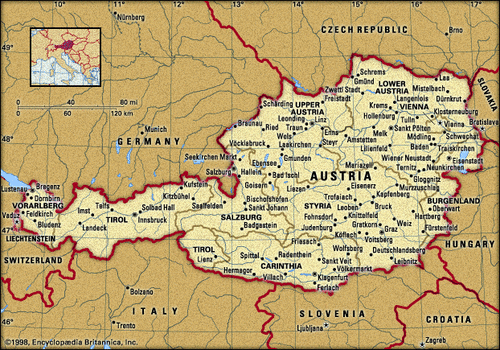-
Welcome in Austria !
Welcome !
I'm Clara and I will tell you my Erasmus semester in Wiener Neustatd, Austria.
Austria is a federal republic and a landlocked country of over 8.5 million people in Central Europe. It is bordered by the Czech Republic and Germany to the north, Hungary and Slovakia to the east, Slovenia and Italy to the south, and Switzerland and Liechtenstein to the west. The territory of Austria covers 83,879 square kilometres and has an alpine climate. The official language is Austrian German and other local official languages are Hungarian, Burgenland Croatian, and Slovene.
Origins of modern-day Austria date back to the time of the Habsburg dynasty when the vast majority of the country was a part of the Holy Roman Empire. During the 17th and 18th centuries, Austria was able to retain its position as one of the great powers of Europe and, in response to the coronation of Napoleon as the Emperor of the French, the Austrian Empire was officially proclaimed in 1804. In 1867, the empire was reformed into Austria-Hungary.
After the collapse of the Habsburg Empire in 1918 at the end of World War I, Austria adopted and used the name the Republic of German-Austria in an attempt for union with Germany. The First Austrian Republic was established in 1919. In 1938, Austria was occupied and annexed by Nazi Germany. This lasted until the end of World War II in 1945, after which Germany was occupied by the Allies and Austria's former democratic constitution was restored. In 1955, the Austrian State Treaty re-established Austria as a sovereign state, ending the occupation.
Today, Austria is a parliamentary representative democracy comprising nine federal states. The capital and largest city, with a population exceeding 1.7 million, is Vienna. Austria is one of the richest countries in the world, with a nominal per capita GDP of $52,216. The country has developed a high standard of living and in 2014 was ranked 21st in the world for its Human Development Index. Austria has been a member of the United Nations since 1955, joined the European Union in 1995, and is a founder of the OECD. Austria also signed the Schengen Agreement in 1995, and adopted the European currency, the Euro, in 1999.
The symbol of Austria is the black eagle on the Austrian coat of arms is the national emblem. The civic crown on its head represents Austria's middle classes; a sickle in its left talon represents its farmers; a hammer in the right, its artisans; and broken silver chains hanging from each talon represent freedom from Nazi German control. The red and white bars of Austria's national flag adorn its breast. These represent the blood-stained tunic worn by Duke Leopold V of Babenberg after the Battle of Ptolemais in 1191. Austria's national anthem is "Land of the Mountains, Land on the River." The edelweiss, Leontopodium alpinum, one of the most famous Alpine plants, is also widely associated with Austria. Celebrated in The Sound of Music, the edelweiss has white star-shaped flowers and grows on rocks and in crevices.
The Austrian-National Day is celebrated of the 26 of October as the Austrian National Day dates back to the birth of the 2nd Republic after WW II. This day marks the day that followed the day on which the last remaining foreign troops left Austrian territory; therefore, it is de facto the first day on which Austria had regained its status as an independent and sovereign state.
Werner FRAYMANN, Federal chancellor
About politics, the government of Austria is a grand coalition government formed by the left-wing Social Democratic Party of Austria (SPÖ) and the right-wing Austrian People's Party (ÖVP). Austrian Federal Government is collective body that exercises executive power in the Republic of Austria. It is composed of the Chancellor, who is leader of the government, the Vice-Chancellor, and senior ministers. The President and the Government together form the executive branch of Austria.
In addition, the government team includes 8 Social Democrats and 8 conservatives. M. Werner FAYMANN is the Federal Chancellor (SPÖ) and M. Reinhold MITTERLEHNER, Vice Chancellor, Minister of Science, Research and Economy (ÖVP).
Since 1929, when the Austrian Constitution has been reformed, all members of the Federal Government are appointed by the Austrian Federal President. The nominations of the ministers takes place at the suggestion of the Chancellor, though the President is permitted to withhold his or her approval. Likewise, the President may dismiss the Chancellor and/or the whole government at any time. However, a new government must be formed by the parties that control parliament.
The government is convened for frequently scheduled meetings. It is the Council of Ministers, which is equivalent to the word "cabinet". The Chancellor presides over cabinet meetings as first among equals without decisional authority, regardless of his right of proposal concerning the appointment of the government's members by the President.
The cabinet adopts resolutions in the presence of at least half of its members and, according to the ruling of the Austrian Constitutional Court, unanimously. Each federal minister is also responsible for his or her own ministry, and may be supported by one or more state secretaries, who also participate in the cabinet's meetings. However, state secretaries are not considered members of the government, and they have no right to vote during cabinet meetings.
-
Commentaires


